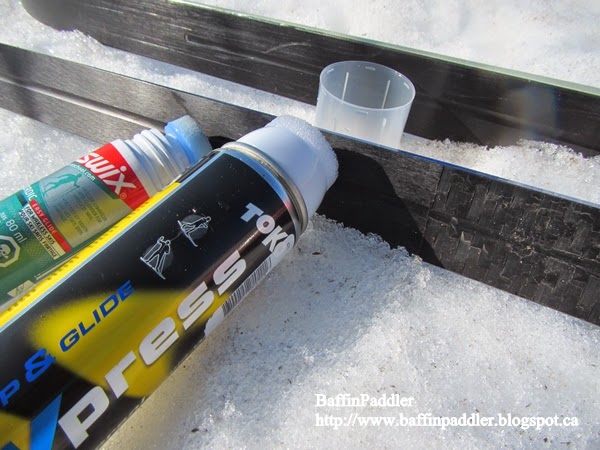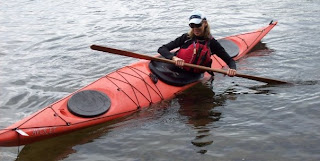Should you put Toko eXpress Universal Liquid Wax on the fish scales of your waxless classic skis? Even if the manufacturer says so?
Well, I can answer that . . . NO!
I already learned my lesson the hard way by listening to the advice of a ski shop in the Tremblant, Quebec region to apply Toko eXpress Universal Liquid Wax to the kick zone (fish scales) of my new waxless, classic, cross-country skis "to protect the fish scales from wear and tear".
Say what! Put a slick, liquid wax on the kick zone (fish scales)? The advice to do so is also written on the product by the manufacturer, ". . . "for kick and glide zones".
Usually the advice is to the contrary. Do not put glide wax on the kick zone (fish scales). This is where the ski needs to engage so you can kick off and advance or climb hills. Only put glide wax on the smooth surface of the classic waxless ski for better glide. The Toko eXpress is called a universal liquid wax for both grip and glide zones.
You can see in the image below, the smooth glide surfaces on the bottom of the ski, and the etched surface in the middle in the kick zone.
Waxless classic skis don't need wax. But we can use a glide wax for a smoother glide and sometimes a faster ride.
Waxable classic skis are another story. They use a grip wax on the kick zone and don't have an etched surface (fish scales). The entire bottom surface of the waxable classic ski is smooth. Classic skiers with waxable skis use a wide range of different waxes for the glide zones depending on conditions and snow temperatures.
I listened to the advice to put the Toko eXpress Universal Liquid Wax for Grip and Glide on the fish scales of my new skis and gave it a try.
Why not? The ski store in Tremblant and the manufacturer must know better than I do, right?
Instant disaster!
Nothing but kick back on my new Rossignol Zymax Classic waxless skis. If you don't know what kick back is on classic x-country skis, think about spinning your wheels on ice. You don't get anywhere. Then think of the next worse scenario - flying down a snowy hill with a long, skinny, classic ski on what feels like slick ice. That's not kick back. It's an overly slick ski picking up more speed than you might be comfortable with.
Once the product was on the fish scales, it didn't seem to wear off. The problem with kick back remained. My new skis were useless, and not returnable. Once you purchase skis and have bindings applied, they are yours.
I needed help and advice on what to do. And the fix was simple.
I already learned my lesson the hard way by listening to the advice of a ski shop in the Tremblant, Quebec region to apply Toko eXpress Universal Liquid Wax to the kick zone (fish scales) of my new waxless, classic, cross-country skis "to protect the fish scales from wear and tear".
Say what! Put a slick, liquid wax on the kick zone (fish scales)? The advice to do so is also written on the product by the manufacturer, ". . . "for kick and glide zones".
Usually the advice is to the contrary. Do not put glide wax on the kick zone (fish scales). This is where the ski needs to engage so you can kick off and advance or climb hills. Only put glide wax on the smooth surface of the classic waxless ski for better glide. The Toko eXpress is called a universal liquid wax for both grip and glide zones.
You can see in the image below, the smooth glide surfaces on the bottom of the ski, and the etched surface in the middle in the kick zone.
 |
| Waxless classic cross-country ski with fish scales on the kick zone |
Waxable classic skis are another story. They use a grip wax on the kick zone and don't have an etched surface (fish scales). The entire bottom surface of the waxable classic ski is smooth. Classic skiers with waxable skis use a wide range of different waxes for the glide zones depending on conditions and snow temperatures.
I listened to the advice to put the Toko eXpress Universal Liquid Wax for Grip and Glide on the fish scales of my new skis and gave it a try.
Why not? The ski store in Tremblant and the manufacturer must know better than I do, right?
Instant disaster!
Nothing but kick back on my new Rossignol Zymax Classic waxless skis. If you don't know what kick back is on classic x-country skis, think about spinning your wheels on ice. You don't get anywhere. Then think of the next worse scenario - flying down a snowy hill with a long, skinny, classic ski on what feels like slick ice. That's not kick back. It's an overly slick ski picking up more speed than you might be comfortable with.
Once the product was on the fish scales, it didn't seem to wear off. The problem with kick back remained. My new skis were useless, and not returnable. Once you purchase skis and have bindings applied, they are yours.
I needed help and advice on what to do. And the fix was simple.
I want to say thank you to the Sports Experts store and the staff at 25 Blvd. du Plateau, Gatineau (Hull sector), Quebec, Canada.
I went to them for a second opinion on my new skis, to verify if they were properly balanced with the binding placement. All was fine. The length of the ski was correct for my size and weight. They helped me solve the kick back problem by removing the Toko eXpress Universal Liquid Wax from the fish scales of my skis with a base cleaner. It was fast and easy. I was impressed with the friendly, efficient, knowledgeable staff and good service at the store. The store is at a convenient location near Gatineau Park.
Once the Toko eXpress Universal Liquid Wax was removed from the fish scales of my skis, they behaved as they should. I had grip and glide and I started to really enjoy my new skis.
Once the Toko eXpress Universal Liquid Wax was removed from the fish scales of my skis, they behaved as they should. I had grip and glide and I started to really enjoy my new skis.
If you need to remove glide wax from the fish scales of your classic waxless cross-country skis, the KUU Bio Citron Base Cleaner worked well for me. It's about $13 CAD. People with waxable skis use this product or use other methods for removing wax.
It might be a good idea to keep a bottle handy during ski season. You never know when a well-meaning ski buddy might apply the glide wax to then entire bottom surface of your classic waxless skis, including the fish scales.
I'm sharing this with you, so that, if this situation ever happens to you, you won't waste as much time as I did figuring out what to do.
I will say though, that I do prefer the Toko eXpress Universal Liquid Wax as a glide wax for the glide sections of my skis. I find it is easier to apply, goes on smoother, and seems to last longer than the Swix Glide Wax.
I don't agree, however, with the advice from the manufacturer that it is for kick and glide zones alike! It made my kick zone too slick.
And now, I know how to easily remove any glide wax from my fish scales if it ever finds its way back where it doesn't belong.
Thanks Sports Experts, for helping me turn this year's ski season into one of my best.
I see they are still sharpening skates, and now, tuning up and repairing bikes. The store is stocked with quality outdoor and sports gear. The repair and service shop is at the back of the store.
I think we've enjoyed the best of spring skiing this year in Canada's National Capital Region and beautiful Gatineau Park, (Quebec, Canada).
 |
| Rossignol Zymax Classic Waxless Cross-country Skis |
There is much to learn about waxing skis. I like to keep it simple and inexpensive. This is why I prefer recreational, waxless, grab n' go, cross-country skis.
This winter, I upgraded my skis from a wider, shorter, lower profile Fisher waxless classic ski, to a longer, slimmer, lighter, Rossignol Zymax Classic waxless recreational performance ski designed for fitness oriented skiers. And . . . I like them. They are faster and have good directional stability.
To wax or not to wax . . . that is the question when making your choice with classic skis.
Lessons learned from the previous ski season make the next one even better! And the end of season sales can still be found online.
Happy trails.
The BaffinPaddler







Comments
Post a Comment